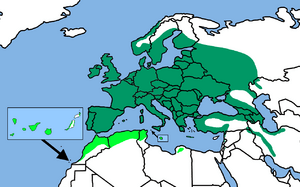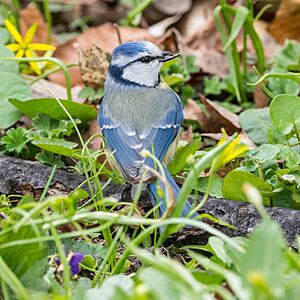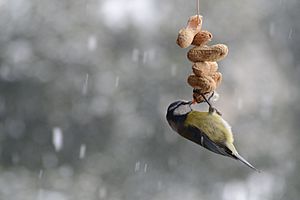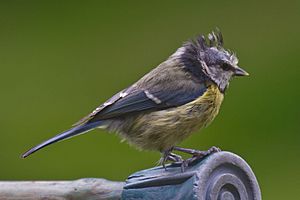Eurasian blue tit facts for kids
Quick facts for kids Eurasian blue tit |
|
|---|---|
 |
|
| A Eurasian blue tit in Lancashire, United Kingdom | |
| Conservation status | |
| Scientific classification | |
| Genus: |
Cyanistes
|
| Species: |
caeruleus
|
 |
|
| Eurasian blue tit range African blue tit range | |
| Synonyms | |
|
Parus caeruleus Linnaeus, 1758 |
|
The Eurasian blue tit (Cyanistes caeruleus) is a small, colorful bird. It belongs to the tit family, Paridae. You can easily spot it by its bright blue and yellow feathers.
These birds usually live in one place and do not migrate. They are common in Europe and western Asia. They like forests with lots of oak trees. Blue tits often build nests in tree holes. They can also use nest boxes that people put out. A bigger bird called the great tit often competes with them for food and nesting spots.
Eurasian blue tits mostly eat insects and spiders. When it's not breeding season, they also eat seeds. These birds are known for being very agile. They can hang upside down from thin branches to find food.
Contents
About the Blue Tit's Name
The Eurasian blue tit got its scientific name, Parus caeruleus, in 1758. This was done by a scientist named Carl Linnaeus. Parus is a Latin word for a tit. Caeruleus means dark blue in Latin.
Later, in 2005, scientists studied the birds' DNA. They found that the blue tit was different from other tits. So, they gave it a new genus name, Cyanistes. This name comes from an ancient Greek word meaning "dark blue."
What Does a Blue Tit Look Like?
A Eurasian blue tit is about 12 centimeters (4.7 inches) long. Its wings can spread about 18 centimeters (7 inches) wide. It weighs around 11 grams (0.4 ounces).
This bird has a bright blue cap on its head. A dark blue line goes through its eye. This line circles its white cheeks and chin. Its back is yellowish-green. The wings and tail are blue. Its belly is mostly yellow. The yellower a bird is, the more yellow-green caterpillars it has eaten. This is because of special colors called carotenes in their food.
Both male and female blue tits look similar to us. But under ultraviolet light, males have a brighter blue cap. Young blue tits are much more yellow than adults.
Where Do Blue Tits Live?
There are many Eurasian blue tits in Europe. Scientists estimate there are 20 to 44 million pairs.
These birds live in many parts of Europe and the Middle East. They prefer places with mild or Mediterranean climates. You can find them in countries like the United Kingdom, France, Germany, and parts of Russia. They are also found in North Africa.
In places like Great Britain, blue tits live in different areas. They are common in woodlands, parks, and gardens. You can even see them in the middle of towns.
Blue Tit Behavior
Eurasian blue tits often join other tit species in winter. They are very good at moving around on thin branches. A blue tit might hop up a tree trunk like a treecreeper. They usually sleep in ivy or evergreen plants. In cold winters, they will sleep in any small hole they can find. This includes tree holes or nesting boxes. They are very flexible and can hang almost anywhere.
These birds are popular in gardens because they are so active. They perform acrobatic moves when eating nuts or suet. They might hang upside down and make chirping sounds.
Reproduction and Life Cycle
Eurasian blue tits will nest in any suitable hole. This can be in a tree, a wall, or a nest box. They often compete with house sparrows or great tits for these spots. Many birds like to use nest boxes. The same hole is often used year after year. If one pair leaves, another pair will take over.
During the time the female sits on the eggs, she does all the incubating. The male brings her food. When the chicks hatch, both parents feed them. They feed the chicks more in the morning.
Blue tit eggs are small, about 14 to 18 millimeters (0.55 to 0.71 inches) long. The size of the eggs depends on the female bird. A female's clutch of eggs can weigh 1.5 times as much as she does!
The female blue tit sits tightly on her eggs. If you try to touch them, she might hiss or bite. This behavior has earned them the nickname "Little Billy Biter" in some parts of the UK. When protecting her eggs, she might raise the feathers on her head. This is a sign of excitement.
Nesting material usually includes moss, wool, hair, and feathers. Eggs are laid in April or May. A blue tit can lay many eggs, but seven or eight is common. Sometimes, a single bird feeds its chicks very often. They can feed them once every 90 seconds during the busiest time. In winter, they join flocks with other tit species.
A blue tit usually lives for about three years. The oldest recorded blue tit in Britain lived for 10 years and 3 months. The oldest one overall lived for 11 years and 7 months in the Czech Republic.
What Blue Tits Eat
Eurasian blue tits eat many insects. They also like young buds from trees, especially when insects are hard to find. They might pull buds apart to look for hidden insects. They are good at catching many types of caterpillars and aphids. They also eat leaf miner grubs. Like other tits, they also eat seeds.
Blue Tit Sounds
Eurasian blue tits use different songs and calls all year. They sing in late winter and spring to protect their territory. They also sing to attract a mate. Calls are used for many reasons.
They use calls to talk to other blue tits. They tell each other where they are in the trees. They also use alarm calls to warn others about predators. This includes other birds like great tits or European robins. For example, they make a scolding sound if they see a fox, cat, or a low-flying bird of prey. Sometimes, other birds join them to mob the predator. A high-pitched whistle warns about flying predators like a Eurasian sparrowhawk. Young birds use a begging call to ask their parents for food.
Clever Blue Tits
Blue tits are known for a special learned behavior. In the 1920s, some blue tits learned to open milk bottles. These bottles had foil tops, and the birds would get to the cream underneath. They taught this trick to other blue tits. This behavior has become less common now. This is because people buy milk in plastic containers with hard lids. Also, many people now drink low-fat milk.
Blue tits also have an instinct to strip bark from trees to find insects. This has sometimes led them to peel building materials. They might peel thatch, wallpaper, or window putty.
Threats to Blue Tits
Because blue tits are small, they can be hunted by larger birds. Jays might catch young blue tits when they leave the nest. The most common predators are sparrowhawks and domestic cats. Mammals like weasels and red squirrels can also raid their nests. In the UK, introduced grey squirrels also pose a threat.
Successful breeding depends on enough green caterpillars for the chicks. Cold and wet weather between May and July can also harm breeding. This is especially true if it happens when caterpillars are emerging.
Blue tits can also host tiny creatures called feather mites. These mites live on the bird's feathers. However, they usually only eat dead feather tissue and don't seem to harm the bird.
Blue Tit Conservation
The Eurasian blue tit is listed as a "least concern" species. This means it is not currently at risk of extinction. The Royal Society for the Protection of Birds in the United Kingdom also considers it a "Green Status" species. This shows that its population is stable.
Blue Tits in Culture
The Eurasian blue tit has appeared on many stamps and decorations. It was recently featured on a British stamp in the 2010 "Birds of Britain" series.
See also
 In Spanish: Herrerillo común para niños
In Spanish: Herrerillo común para niños







